PVH Bundle
How Does PVH Corp. Thrive in the Fashion World?
PVH Corp., a global apparel giant, is a powerhouse in the fashion industry, best known for iconic PVH SWOT Analysis brands like Calvin Klein and Tommy Hilfiger. With over 130 years of history, PVH has transformed into a diversified lifestyle organization, operating in more than 40 countries. Understanding the PVH business model is key to grasping its success.
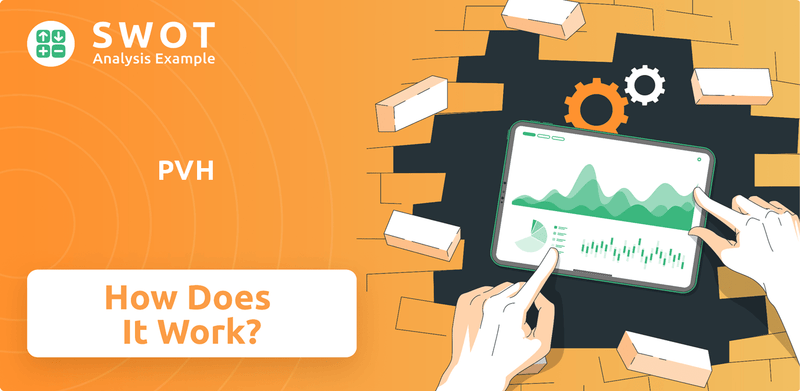
This exploration into PVH Company will uncover its operational strategies, revenue streams, and strategic direction. We'll analyze how PVH brands navigate market challenges, such as evolving consumer preferences and international trade dynamics. This comprehensive analysis will provide valuable insights into the resilience and future growth potential of this leading apparel company, answering questions like: How does PVH Company operate its supply chain, and what is the future outlook for PVH stock?
What Are the Key Operations Driving PVH’s Success?
The core of the PVH Corp business lies in designing, sourcing, marketing, and distributing branded apparel and lifestyle products. This is primarily achieved through its globally recognized PVH brands, including Tommy Hilfiger and Calvin Klein. These brands cater to various consumer segments by offering premium and contemporary fashion, ensuring a diverse product range that appeals to a broad audience, including young urban professionals.
PVH Corp's value proposition centers on providing high-quality, trend-driven clothing. The company is committed to driving fashion forward while upholding ethical and sustainable practices. This commitment is reflected in its operational strategies and brand values, aiming to deliver both style and responsibility to its consumers.
The operational model of PVH Corp involves a multi-channel distribution strategy. This includes wholesale partnerships, direct-to-consumer retail and outlet stores, and a robust e-commerce presence. Digital channels are significant, accounting for 36.3% of total revenues in 2022. Licensing agreements further extend its market reach without substantial capital investment.
PVH Corp uses a multi-channel distribution network to reach consumers. This includes wholesale, retail, and e-commerce channels, maximizing market penetration. The company operates retail and outlet stores to enhance brand visibility and offer direct-to-consumer sales.
Licensing is a key part of PVH Corp's strategy, allowing it to expand its brand presence. These agreements enable the production and distribution of products under its brand names. This strategy helps in reaching a wider audience with minimal capital investment.
E-commerce platforms are crucial for PVH Corp's operations, supporting direct-to-consumer sales. Digital channels accounted for 36.3% of total revenues in 2022. This digital presence expands market reach and enhances customer engagement.
PVH Corp manages a global supply chain to optimize production costs and ensure product quality. They work with approximately 1,000 factories in over 30 countries as of 2024. This global network allows access to diverse markets and growth opportunities.
PVH Corp employs a strategic approach of direct control and collaboration. They maintain direct control over core lifestyle categories, such as underwear, sportswear, and jeans. They also outsource specialized categories like outerwear to experts.
- This approach allows for risk mitigation and efficiency.
- It enables the company to leverage external expertise.
- This translates into a consistent brand experience for customers.
- It also supports market differentiation through a diverse product offering.
For more insights into the competitive landscape of PVH Corp, consider reading about the Competitors Landscape of PVH.
PVH SWOT Analysis
- Complete SWOT Breakdown
- Fully Customizable
- Editable in Excel & Word
- Professional Formatting
- Investor-Ready Format
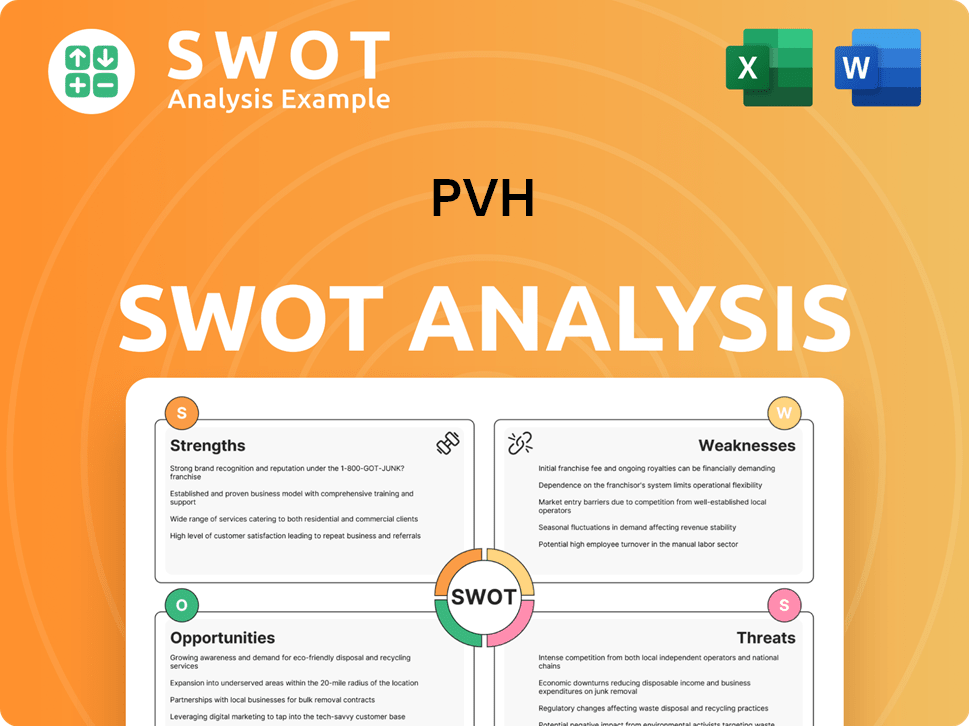
How Does PVH Make Money?
The core of the revenue model for the PVH Corp revolves around the design, marketing, and sale of apparel and accessories. This is primarily driven by its globally recognized brands, including Tommy Hilfiger and Calvin Klein. The company's revenue streams are diversified across wholesale, retail, and licensing agreements.
For the fiscal year ending February 2, 2025, PVH Corp reported an annual revenue of $8.65 billion. This represents a 6.13% decrease year-over-year, reflecting the dynamic nature of the fashion retail market. In the fourth quarter of 2024, revenue totaled $2.372 billion, marking a 5% decline compared to the corresponding period of the previous year.
PVH's monetization strategies also involve leveraging its strong brand portfolio through licensing agreements. This approach allows for brand expansion without significant capital investment. The company has been focusing on its PVH+ Plan, which aims to improve sales quality, drive gross margin improvements, and enhance cost efficiencies.
PVH Corp generates revenue through wholesale, retail (company-owned stores and outlets), and licensing channels. The company leverages its portfolio of brands, particularly Tommy Hilfiger and Calvin Klein, to drive sales across these channels. Licensing agreements provide an additional avenue for revenue generation, expanding brand presence without significant capital investment.
In Q4 FY24, Tommy Hilfiger revenue decreased by 5% year-over-year, with international sales down 7%. Calvin Klein experienced a 2% revenue drop, offset by a 3% increase in North America. Heritage Brands saw a 41% decline. Direct-to-consumer revenue decreased by 5%, with owned stores down 4% and digital commerce down 10%.
The PVH+ Plan focuses on increasing sales quality and driving gross margin improvements. Strategic focus on direct-to-consumer sales, which have higher margins, and digital sales, which account for a significant portion of total revenue, are key strategies. The company aims to optimize its channel mix and manage costs effectively.
Despite a gross margin contraction to 58.2% in Q4 FY24 from 60.3%, the company achieved record gross margins and a double-digit non-GAAP EBIT margin in 2024. The focus on direct-to-consumer and digital sales contributes to higher margins. The company is focused on improving profitability through strategic initiatives.
Digital sales are a crucial part of PVH's monetization strategy, accounting for a significant portion of total revenue. The company is investing in its digital channels to enhance customer experience and drive sales growth. Digital commerce plays a key role in the company's long-term growth strategy.
The PVH+ Plan is designed to improve the quality of sales and enhance cost efficiencies. This strategic plan aims to drive gross margin improvements and optimize overall profitability. The plan's success is vital for the company's financial performance and future growth.
PVH Corp's revenue model is based on a multi-channel approach, with a strong emphasis on its core brands. The company's financial performance in Q4 FY24 reflects the dynamic nature of the apparel market. Strategic initiatives, such as the PVH+ Plan, are aimed at driving profitability and enhancing long-term growth. For further insights, consider exploring the Target Market of PVH.
- PVH's revenue streams include wholesale, retail, and licensing.
- Tommy Hilfiger and Calvin Klein are key drivers of revenue.
- The PVH+ Plan focuses on improving sales quality and margins.
- Digital commerce and direct-to-consumer sales are growing in importance.
- The company is focused on cost efficiencies and strategic channel management.
PVH PESTLE Analysis
- Covers All 6 PESTLE Categories
- No Research Needed – Save Hours of Work
- Built by Experts, Trusted by Consultants
- Instant Download, Ready to Use
- 100% Editable, Fully Customizable
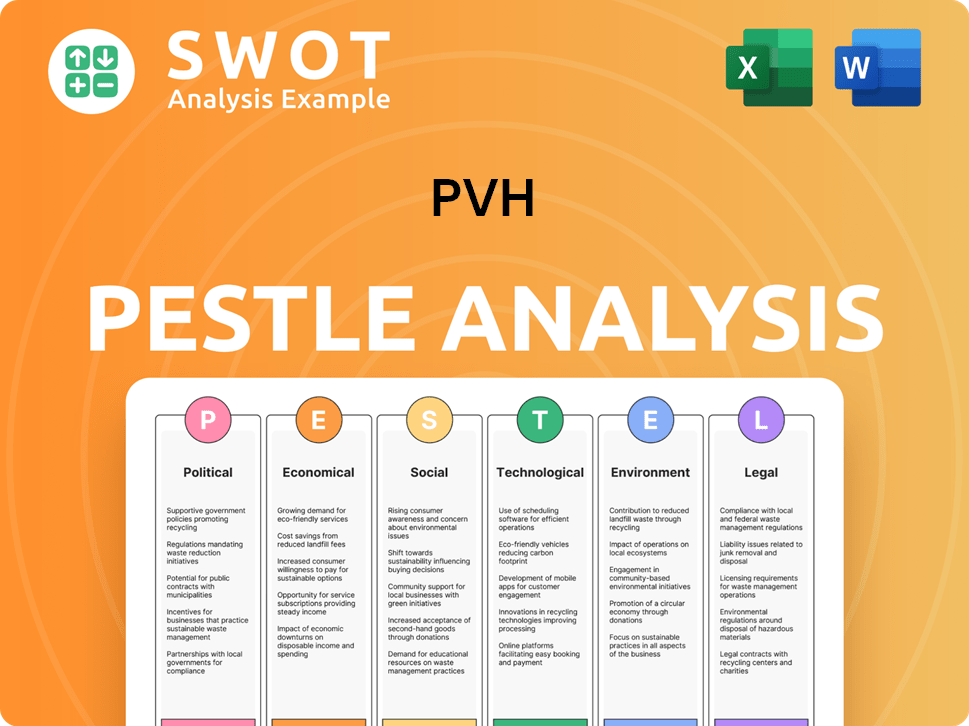
Which Strategic Decisions Have Shaped PVH’s Business Model?
The evolution of PVH Corp., a global apparel company, is marked by strategic shifts and significant milestones. The company's focus on its core brands, particularly Calvin Klein and Tommy Hilfiger, has driven its operational and financial strategies. The PVH business model centers around brand building, digital expansion, and operational efficiency to enhance shareholder value and market presence.
A core element of PVH Corp.'s strategy is the PVH+ Plan, launched in April 2022. This plan emphasizes product innovation, consumer engagement, digital marketplace dominance, data-driven operations, and efficiency improvements. These initiatives are designed to strengthen the company's leading brands and adapt to the evolving retail landscape. The company's commitment to shareholder returns is demonstrated by its accelerated share repurchase programs.
Recent strategic moves, such as divesting non-core businesses and entering licensing partnerships, highlight PVH Corp.'s focus on streamlining operations and leveraging external expertise. These actions, combined with investments in digital channels and supply chain optimization, position the company to meet challenges and capitalize on growth opportunities in the global apparel market. The company is constantly adapting to the market, including experimenting with AI-driven demand forecasting and sustainable materials.
In November 2023, PVH Corp. sold its Heritage Brands women's intimates business, streamlining its portfolio. In April 2025, the company announced plans for $500 million in accelerated share repurchases, following a similar amount in 2024, reflecting confidence in future performance. A significant licensing partnership was established in June 2025 with Herman Kay-Mystic LLC for outerwear production.
The company is strategically reducing sales in Europe to improve overall sales quality while experiencing robust growth in the Asia-Pacific region. Investment in digital channels is a key growth driver. The PVH+ Plan, launched in April 2022, guides the company's strategic initiatives. These moves aim to enhance profitability and market position.
The company benefits from a strong brand portfolio, including Calvin Klein and Tommy Hilfiger, which have global recognition. PVH Corp. leverages economies of scale through efficient supply chain management and a global reach, operating in over 40 countries. Licensing agreements further expand brand reach without significant capital investment. The company is also focusing on cost efficiencies and targeted investments.
In 2024, PVH Corp. repurchased $500 million in shares, showcasing its commitment to shareholder returns. The company's digital channels are experiencing strong growth, enhancing online sales. The strategic focus on key brands and operational efficiency is designed to drive sustainable financial performance. For more insights, you can explore the Marketing Strategy of PVH.
The PVH+ Plan launched in April 2022, focuses on five key drivers: winning with product, winning with consumer engagement, winning in the digitally-led marketplace, developing a demand and data-driven operating model, and driving efficiencies and investing in growth. These initiatives are designed to strengthen the company's leading brands and adapt to the evolving retail landscape.
- Focus on core brands, particularly Calvin Klein and Tommy Hilfiger.
- Investment in digital channels to enhance online sales and customer experience.
- Strategic portfolio management, including divesting non-core businesses.
- Emphasis on cost efficiencies and targeted investments to improve profitability.
PVH Business Model Canvas
- Complete 9-Block Business Model Canvas
- Effortlessly Communicate Your Business Strategy
- Investor-Ready BMC Format
- 100% Editable and Customizable
- Clear and Structured Layout
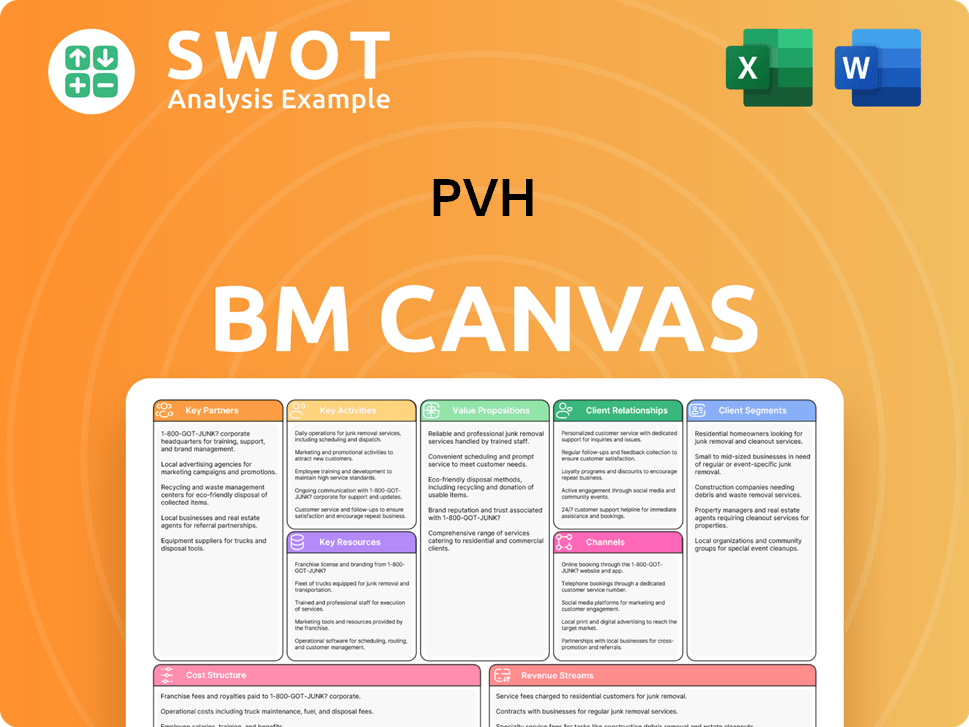
How Is PVH Positioning Itself for Continued Success?
PVH Corp. (PVH) is a major player in the global apparel industry, known for its PVH brands, including Calvin Klein and Tommy Hilfiger. While precise 2024-2025 market share data isn't readily available, in 2020, the company ranked second in the world based on revenue among apparel companies. Its global presence spans over 40 countries, supported by a network of retail stores, online platforms, and partnerships. The company focuses on consistent brand experiences and associate development to maintain brand messaging and customer satisfaction.
However, PVH faces several challenges. These include macroeconomic uncertainties, which can affect consumer spending, especially in Europe, where a significant portion of its sales originate. Trade volatility and tariffs, such as those on U.S. imports, are also projected to negatively impact earnings per share (EPS). Additionally, investigations into cotton sourcing practices in China have placed the company on a list that could restrict its business there. Effective inventory management and aligning stock levels with demand are ongoing crucial challenges.
PVH Corp. holds a significant position in the global apparel market, competing with other major brands. Its portfolio includes well-known labels such as Tommy Hilfiger and Calvin Klein. The company's wide distribution network and brand recognition contribute to its strong industry standing.
PVH faces risks such as economic downturns impacting consumer spending. Trade policies and tariffs can also affect profitability. Furthermore, supply chain disruptions and geopolitical issues pose challenges. These factors require careful management to mitigate their impact on the company.
PVH is focused on its PVH+ Plan, aiming for growth and operational efficiency. The company is investing in digital transformation and cost savings. Capital returns to shareholders, including share repurchases, are also planned. The company's future depends on its ability to navigate risks and adapt to changing consumer preferences.
PVH's strategic initiatives include digital transformation and cost optimization. The company is focused on enhancing brand relevance and operational leverage. These initiatives are designed to drive sustainable growth and improve financial performance. Further information can be found in this article about PVH How Does PVH Company Work?.
For 2025, PVH anticipates flat to slightly increased revenue compared to 2024. Non-GAAP EPS is projected to be in the range of $10.75 to $11.00. The company plans to continue returning capital to shareholders, with $500 million in accelerated share repurchases planned for 2025.
- The company is implementing its Growth Driver 5 multi-year cost savings initiative.
- PVH is focused on enhancing brand relevance.
- Continued investment in digital transformation is a key strategy.
- Navigating geopolitical risks and managing supply chain complexities are crucial.
PVH Porter's Five Forces Analysis
- Covers All 5 Competitive Forces in Detail
- Structured for Consultants, Students, and Founders
- 100% Editable in Microsoft Word & Excel
- Instant Digital Download – Use Immediately
- Compatible with Mac & PC – Fully Unlocked
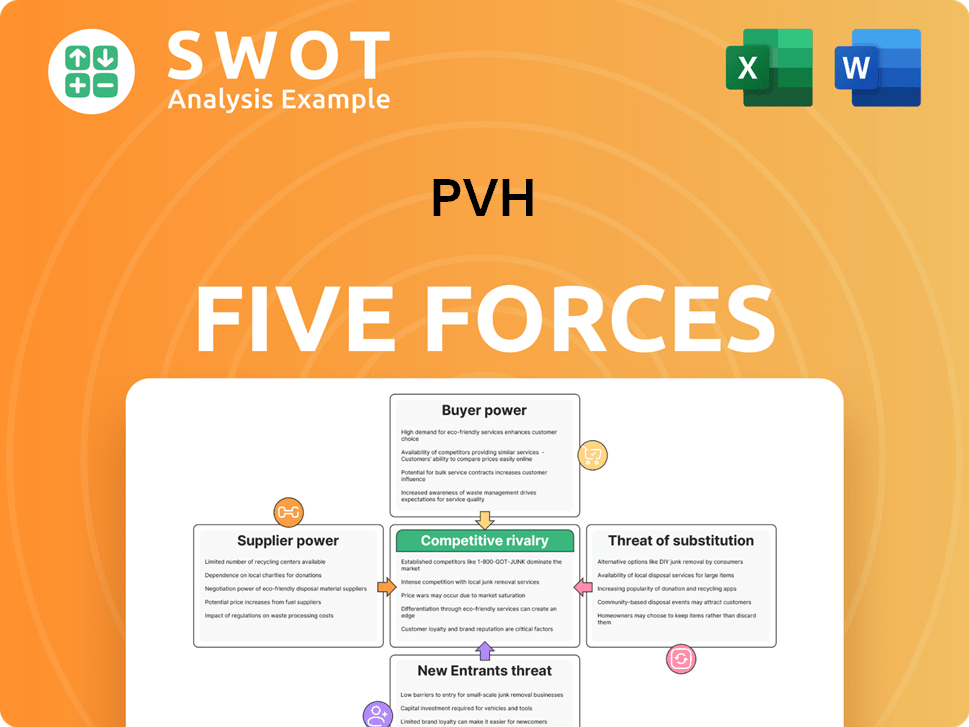
Related Blogs
- What are Mission Vision & Core Values of PVH Company?
- What is Competitive Landscape of PVH Company?
- What is Growth Strategy and Future Prospects of PVH Company?
- What is Sales and Marketing Strategy of PVH Company?
- What is Brief History of PVH Company?
- Who Owns PVH Company?
- What is Customer Demographics and Target Market of PVH Company?
Disclaimer
All information, articles, and product details provided on this website are for general informational and educational purposes only. We do not claim any ownership over, nor do we intend to infringe upon, any trademarks, copyrights, logos, brand names, or other intellectual property mentioned or depicted on this site. Such intellectual property remains the property of its respective owners, and any references here are made solely for identification or informational purposes, without implying any affiliation, endorsement, or partnership.
We make no representations or warranties, express or implied, regarding the accuracy, completeness, or suitability of any content or products presented. Nothing on this website should be construed as legal, tax, investment, financial, medical, or other professional advice. In addition, no part of this site—including articles or product references—constitutes a solicitation, recommendation, endorsement, advertisement, or offer to buy or sell any securities, franchises, or other financial instruments, particularly in jurisdictions where such activity would be unlawful.
All content is of a general nature and may not address the specific circumstances of any individual or entity. It is not a substitute for professional advice or services. Any actions you take based on the information provided here are strictly at your own risk. You accept full responsibility for any decisions or outcomes arising from your use of this website and agree to release us from any liability in connection with your use of, or reliance upon, the content or products found herein.